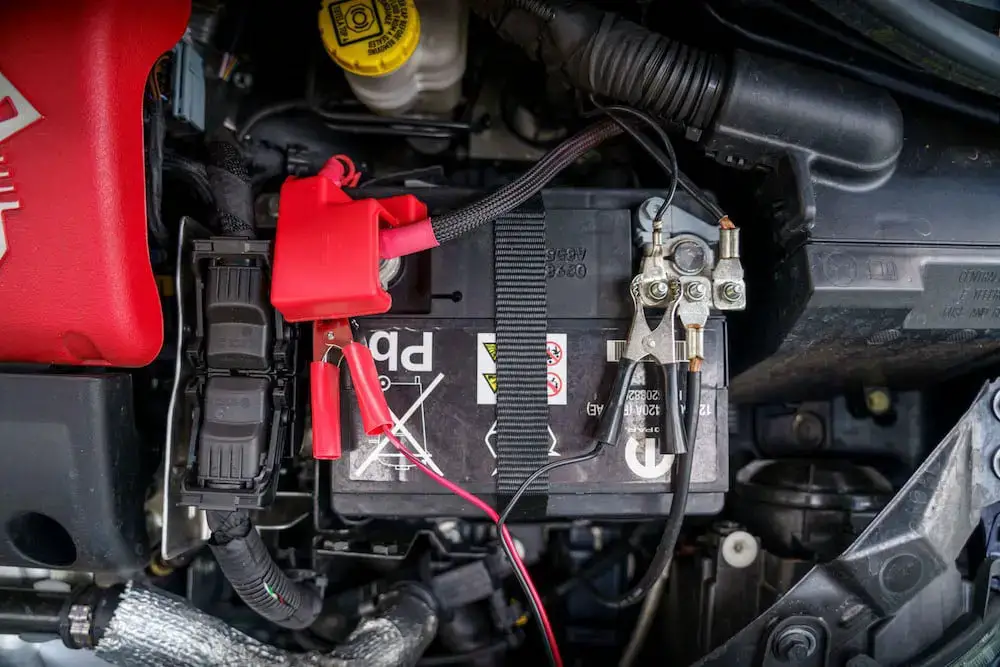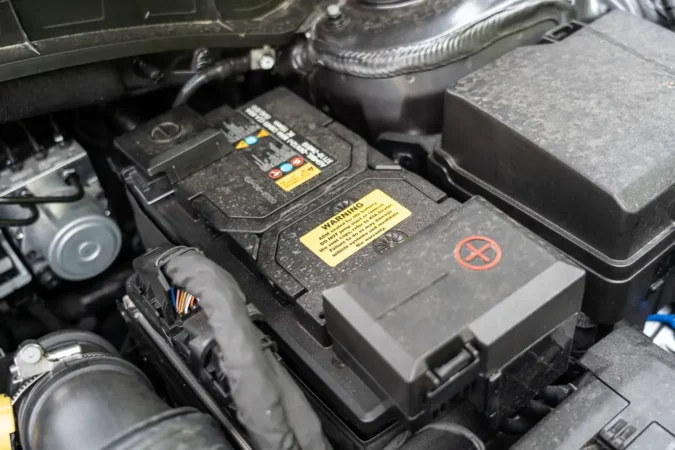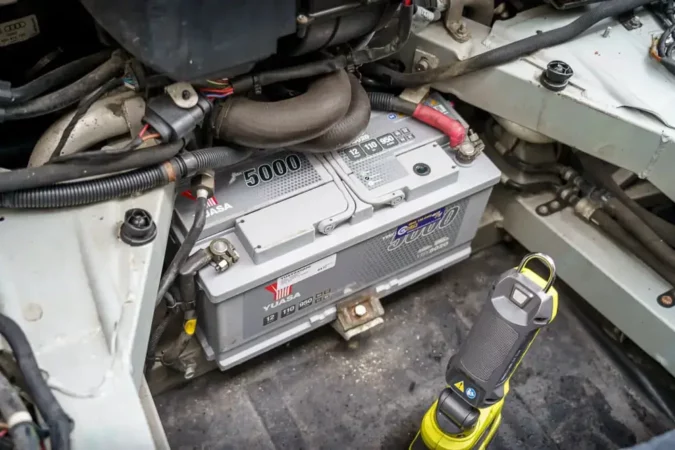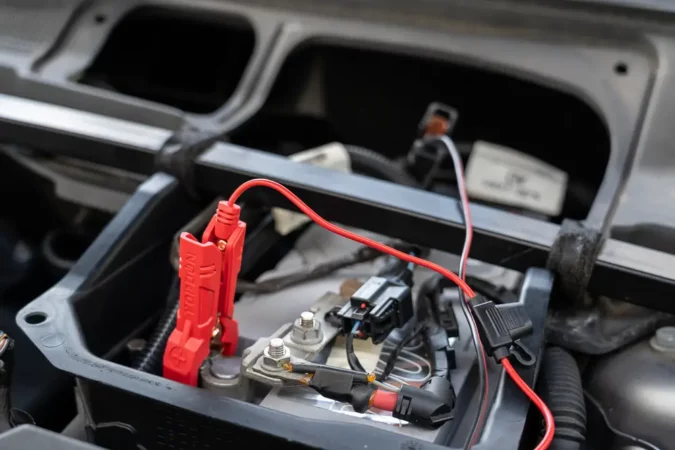What drains a car battery? When your car doesn’t start while you’re late for a meeting, it can be one of the scariest circumstances you’ve ever experienced. When you quickly get in your automobile, it won’t start.
Or, if you have a new battery, but your car won’t start with it, regardless. The engine merely stutters and dies with each turn of the key, the headlights are dim, and the ignition is weak. Only in these circumstances do we recognize that the battery is dead.
But have you ever considered what the most prevalent causes are? They are basic mistakes people make, such as forgetting to close the trunk of their automobile or turning on a light inside. Let’s discover more.
- Why a Battery Degrades
- What are the Reasons?
- Bad Alternator and Battery
- Battery Discharge Warning
- What to do?
- Importance of Wire Connection
- Steps to Take for a Fix
- FAQs
How Come Car Batteries Degrade
The list of problems that can kill a car battery is vast and seems to go on forever. Still, almost every battery killer can be grouped into one of three categories: battery issues, electrical system issues, or simple user mistakes.
It’s impossible to know for sure unless you get your hands dirty and start working on these things. But some of these can be handled at home, and others will surely need a trip to your mechanic. It’s crucial to remember that when most people talk about a battery dying frequently.
They usually mean when a car won’t start after being parked. There are also puzzling issues such as how your car won’t start but the battery is good. It’s more likely that you have a problem with the charging mechanism if your battery seems to die while you’re moving down the road.
8 Reasons Why Car Battery Keeps Dying
There are a number of possible causes of your car battery dying overnight, which might explain what drains a car battery.
1. You Failed To Properly Turn Off Your Vehicle
Your car may have lost charge quickly because you failed to properly switch it off, which is a typical mistake. For instance, you might have left your door slightly open, the boot open, or the interior light on. Many cars still demand physical effort, however, some autos will turn off the lights if they’ve been on for too long or will beep a warning.
The battery’s lifespan may be shortened due to the ongoing drain if your automobile is not periodically turned off completely. Before leaving the automobile, ensure the lights and doors are turned off and locked securely.
2. Parasitic Battery Drain
When your car’s battery continues to discharge after it has been parked and the discharge rate is substantially higher than usual, this is referred to as a parasitic drain. The drain is typically caused by a broken automobile component. Such as a sensor or an interior light that doesn’t switch off immediately.
The attachment will continue to use power until it is manually turned off. A broken computer module, alarm, headlight, boot or glove box light, or other electrical component are examples of further such defective accessories.
A mechanic can quickly determine whether you have a parasite drain by conducting a parasitic draw test. A parasitic draw test is a diagnostic operation used on an automobile’s electrical system to find and quantify any current drain that occurs when the car is in the “off” position.
This test is run to find any electrical components that are still consuming power even when the engine is off, slowly draining the battery. To isolate the cause of the drain, various electrical components are disconnected during the test, and the battery’s current drain is measured using an ammeter over a predetermined amount of time.
To find out if a car’s battery is being parasitically drained, utilize a battery drain tester. For more insight, check out our guides on how to test a car battery.
3. A Faulty Alternator
Every time your automobile shifts into gear, an alternator recharges the battery and supplies electricity to the accessories. You can notice strange noises from your automobile, flickering lights, or other problems if the alternator diode fails.
When the alternator breaks out, the battery loses charge until it eventually can no longer start the automobile (as is the case when you have a new alternator but it’s not charging the battery). To give your car the power it needs to get to a shop for repairs in this situation, you will need to jump-start it.
To learn more, you can check out our explainers on why you have a new battery, but your car won’t start without a jump.
4. A Deteriorating Battery
As you drive your car more regularly, the battery may start to malfunction. If the battery in your car is old and worn out, you might notice corrosion or a loss in performance. It could be time to buy a new battery if you notice these symptoms on the one in your car. By having the batteries inspected by a pro, you can be sure of this.
If the automobile won’t start after you jump it, the battery is dead and has no longer life. A battery’s lifespan, normally five years, is affected by a number of variables. Including how frequently it is used, the weather, and the amount of stress it is subjected to.
5. Making Regular Short Journeys
When a car begins, the battery generates a rush of power. The alternator recharges the battery after your automobile moves to make up for the energy spent to start and maintain it. The alternator might not have enough time during a brief journey to recharge the battery. Therefore, making lots of short excursions can harm the battery in your automobile.
6. A Loose Battery Terminal
Cables connect positive and negative terminals on your car battery. It is common to disconnect these out of an abundance of caution before working on your car. For more references, do check out our guide on how to safely disconnect a car battery. Also, you might find our write-ups on positive or negative first when connecting a battery handy.
The norm is often a red cable (or connector) for positive and a black cable (or connector) for negative, though this may not always be the case. Most batteries include plus and minus symbols to indicate the terminals. Never cut the positive cord before the negative.
The battery could discharge if these cables come loose. A heated ground wire cable, fluttering headlights, and difficulties starting the car are all signs that there are loose cables. The wires can be tightened and reinstalled properly to fix this, but you should always exercise caution when working on a car’s electrical system to prevent shocks or other harm to the automobile.
Therefore, electric or hybrid vehicles should only be serviced by expert personnel. Get expert advice if you have any doubts at all. Another potential cause of your battery’s poor performance is corrosion at the battery terminals. There are, thankfully, easy ways of cleaning battery terminal corrosion.
7. Unfavorable Weather
Extremely hot or cold temperatures might impact the performance of your car’s battery. The chemical reactions occurring in the battery are impacted by temperature, which can impact the battery’s effectiveness and durability.
When it’s chilly outside, your car may need to be started with twice as much energy. In the summer, your battery’s essential liquids could evaporate, which could lead to corrosion and raise the likelihood that it will malfunction.
8. The Battery’s Age
The manufacturer typically indicates a battery’s useful life. Most of the time, it can take two to three years. Once that period of time has elapsed, they discharge too quickly and do not fully recharge. At that point, you ought to think about a replacement (and consider the car battery replacement cost). Not to mention, the question of how much is a car battery.
Even when stored, a battery that has passed its manufacturer-specified expiration date will soon lose charge.
Bad Alternator vs Bad Battery
A malfunctioning alternator might bring on numerous electrical issues with a car. While the engine is running, the alternator recharges the battery and gives electricity to the electrical system. The alternator may not provide adequate voltage if it fails to maintain the battery’s charge and power the electrical system, which can cause the symptoms listed below:
- The dashboard’s battery warning light coming on
- Failing to start or stalling an engine
- Electrical components not working or working occasionally
- Flashing or dimming lights
On the other hand, a defective battery may elicit the same symptoms, but it frequently has trouble holding a charge and starting the car. When the engine is not running, the battery powers electrical parts and supplies the initial surge of power required to start the engine. Therefore, it’s crucial to understand if you have a bad alternator vs a bad battery.
The battery’s inability to maintain a charge (and cause issues relating to what drains a car battery) might result in the following:
- The engine won’t turn over or cranks slowly
- Electrical systems not working properly or not working at all
- Dim or flashing lights, including headlights
It can occasionally be challenging to distinguish between a damaged alternator and a bad battery because their symptoms are similar. As well as, the symptoms of a weak car battery. To fully diagnose the problem and choose the best course of action, it is crucial to test the battery and charging system.
Battery Discharge Warning
A vehicle’s performance and operation might suffer in several ways when the battery is low on power. A partially depleted battery can make it harder for the engine to start, provide less power to electrical parts, and increase the likelihood that you’ll get stuck. In rare circumstances, a fully depleted battery may make it impossible for the car to start at all, necessitating a jump start or battery replacement.
It is advised to take precautions like driving the car frequently, shutting off electrical devices when not in use, and avoiding extended periods of inactivity to assist reduce battery drain. Regular testing of the battery and charging system is also necessary to ensure they are in good shape and working correctly.
By following these instructions, you can help ensure that your car battery performs dependably and spare yourself the trouble and expense of a dead battery.
Car Battery Dead
There are a few things you can do to get back on the road if your car battery dies (and you’ve determined what drains a car battery):
- Jump Start the Battery: You can jump-start your car if you have jumper cables and access to another vehicle with a functional battery. Simply connect the cords to the other vehicle’s working battery and the dead one, turn it on, and then start your car.
- Charge the Battery: If you don’t have access to another car, you can charge the battery with a portable battery charger or a jump starter. The charger must only be connected to the battery, turned on, and left to charge. Before that, make sure you’re also aware of how long does it take to charge a car battery. Also, we have a list of the best car battery charger to help you out!
- Replace the Battery: If the battery in your vehicle is dead and unable to be charged or jump-started, you may need to replace it. A qualified mechanic can handle this, or if you have the required equipment and knowledge, you can handle it yourself.
Whatever action you take, it’s critical to identify the root of the dead battery to avoid it from happening again. To find out if there are any underlying problems and to make any necessary repairs. You might wish to have a mechanic evaluate your battery and charging system.
Importance Of Battery Wire Connection
A car’s electrical system depends heavily on battery wire connections since they transmit power from the battery to the rest of the car. Proper battery wire connections are essential to guarantee dependable power transmission, prevent power loss, and prevent damage to the battery and other electrical components.
The following steps must be taken to ensure good battery wire connections:
- The battery terminals should be cleaned since corrosion, rust, and dirt can accumulate there and hinder power transmission. To remove any buildup, use a wire brush and a solution of baking soda and water to clean the terminals and the surrounding surfaces.
- Battery wires should be tight; otherwise, power loss and battery damage may result. Verify that the cables connecting the battery and alternator are snug and stable.
- To replace any frayed, cut, or damaged cables, look for them and inspect them.
- Check for rust because it can hinder power transmission, harm the battery, and affect other electrical parts. Apply a protective coating, such as petroleum jelly, to any rusted areas after cleaning them with a solution of baking soda and water. This will stop additional corrosion.
- For a car to operate reliably and to prevent expensive repairs, the battery wiring connections must be made correctly. Your battery wire connections may be kept in good shape and work properly with routine maintenance and examination.
Car Battery Dying While Driving
When a car battery fails while driving, it may indicate a more serious electrical system problem. Here are a few typical reasons why a car battery will eventually die:
- If the alternator is malfunctioning, it may not be charging the battery, which could lead to the battery dying while driving.
- Battery connections that are loose or corroded may be unable to transfer power efficiently. Which could result in the battery discharging while the vehicle is in motion.
- A battery can age and lose its capacity to hold a charge, which can result in a crash while you’re driving.
- If the electrical system is overloaded with several gadgets or systems, the battery could die while you’re driving.
- A short circuit in the electrical system of the car could deplete the battery and kill it while you’re driving.
A mechanic should examine the battery and charging system as soon as possible if your car battery is running out while you’re driving to determine the root of the problem and make any necessary fixes. In addition to leaving you stranded, driving with a dead battery can harm the battery and alternator.
Steps When Car Battery Completely Dead
There are various symptoms of a dead battery (once you’ve figured out what drains a car battery), including:
- The Engine Won’t Start: When you turn the key in the ignition, the engine won’t start if the battery is entirely dead.
- Dim or Unresponsive Lights: If the battery is fully dead, the interior and dashboard lights may be dim or unresponsive when the door is opened, or the ignition is turned on.
- The Starter is Silent: When you turn the key in the ignition with a completely dead battery. You can hear a clicking sound, but the starter won’t engage, and the engine won’t turn over.
- Zero Voltage Multimeter Reading: If you have a multimeter, you can check the battery voltage. It should indicate 0 volts if the battery is entirely dead. To learn more, be sure to check out our overview of how many amps is a 12-volt car battery.
- Slow Engine Crank: When the ignition key is turned, a weak battery may cause the engine to start slowly or not at all.
- Dead Power Windows: When you press the button, the power windows might not operate if the battery is dead.
- Dead Battery: A dead battery may cause the radio or infotainment system not to operate or to display an error message.
- Check Engine Light: The Check Engine light may turn on due to a dead battery.
It’s likely that your battery is entirely dead and has to be jump-started, charged, or replaced if you’re exhibiting any of these symptoms. If you are replacing the battery, make sure you also understand factors such as the different car battery sizes. Or, perhaps knowing the best car battery brand out there. Not to mention, learning how much does a car battery weigh.
FAQs On What Drains A Car Battery
Here are some popular FAQs about what drains a car battery:
How Long Does A Car Battery Last
A car battery typically lasts three to five years. Car batteries can vary in lifespan, with some lasting up to 7 years while others only 2 to 3 years.
Why Is My Battery Draining So Fast
A parasitic load, a broken alternator, a short circuit, or leaving electrical components on when the engine is off can all contribute to a battery that drains quickly.
How To Charge A Car Battery
A car battery can be charged with a battery charger or jump-started with a set of jump leads and an operational vehicle. According to the manufacturer’s recommendations, connect the charger or jump leads, and then let the battery charge for the advised period of time.
Can A Car Battery Die While Driving
Yes, a car battery can fail while you’re driving, although that rarely happens. The alternator, which charges the battery while the engine is running, is typically to blame for a dead battery while driving. It is recommended to get the battery and alternator checked by a mechanic if you suffer a dead battery while driving.
How To Reconnect A Car Battery
Finding the positive and negative terminals, cleaning them, connecting the positive cable to the positive and negative terminals to the negative terminal, and tightening the clamps are all necessary steps in reconnecting a car battery. Start the engine afterward, and look for any problems or warning lights.
How To Tell If The Alternator Is Draining Battery
By shutting off all electrical components and checking the battery voltage with a multimeter. You can conduct a voltage drop test to see whether the alternator is drained the battery. Significant voltage reductions could signal that the alternator is malfunctioning and draining the battery parasitically. To confirm the problem, you can also look for any loose or damaged wiring and have the alternator checked by a specialist.
What Charges The Battery In A Car
While the engine is running, the alternator in an automobile charges the battery. The alternator transforms the engine’s mechanical energy into electrical energy to charge the battery and power the car’s electrical system.
What To Do When Battery Dies In Car
A set of jump leads and a running vehicle can be used to jump-start a dead automobile battery, or you can use a portable battery charger. Have the battery and alternator checked by a mechanic to rule out any underlying problems if jump-starting doesn’t work.
Does The Alternator Charge The Battery
In a car, the alternator is in charge of charging the battery. To power the car’s electrical system and refuel the battery, it transforms mechanical energy from the engine into electrical energy.
Can An Alternator Drain A Battery
Yes, a malfunctioning alternator can drain the battery if it fails to charge it properly or draws power from the electrical system inadvertently.
How To Fix Dead Battery In Car
You may jump-start a dead battery in a car, use a portable battery charger to recharge it or buy a new battery to repair the problem. Have the alternator inspected by a mechanic to identify any underlying problems if the battery keeps dying.
Can A Bad Starter Drain A Battery
Unreliable starters can deplete a battery if they continue to operate even after the engine has been started or if they continue to draw power even when the engine is not operating. The battery may have a parasitic drain as a result, rapidly discharging.
What To Do If Your Car Battery Dies
If the battery in your car dies, you can use a portable battery charger or a set of jump leads to jump-start it. Have the battery and alternator checked by a mechanic to rule out any underlying problems if jump-starting doesn’t work.
How Long Before Car Battery Dies With Radio On
The battery’s capacity, the radio’s power requirements, and the battery’s charge level will affect how long a car battery will last when the radio is on. Most automobile batteries can often operate with the radio on for 1-2 hours before they run out of power. However, depending on unique conditions, this can vary significantly.
How Long To Run Car To Charge Battery
An automobile battery can be fully charged in 30 to 60 minutes of driving. However, this may change depending on the battery’s capacity, the alternator’s power, and the battery’s charge level. To give the alternator enough time to properly charge the battery. It is advised that you drive the automobile for at least 15 minutes.
What Does The Battery Control Module Do
The battery control module is an electronic component in a car that controls how the battery is charged and discharged. It keeps track of the battery’s voltage and current and modifies the alternator’s output to keep the charge healthy. The battery control module guards against both overcharging and over discharging of the battery. It increases the battery’s lifespan and ensures the optimum operation of the electrical system.
How To Check For Parasitic Draw
You can use a multimeter to test the battery’s current draw while all electrical loads are off to check for parasitic draw. All electrical loads should be turned off before connecting the multimeter in series with the battery’s negative terminal and ground. The maximum permissible parasitic draw is 50 milliamps. A mechanic should be called to identify and fix the problem if the current draw is higher.
What Drains A Car Battery: Final Verdict
What drains a car battery? A car battery’s primary job is to assist with engine starting. After then, all of the vehicle’s electrical components are powered by the alternator, which transforms mechanical energy into electrical energy. But for the procedure to even begin, the automobile battery must be in good working order.
Depending on how often you drive your car and the weather where you are, a car battery should last between 2 and 5 years. However, the automobile battery is being drained of its power too quickly if you find that it is losing too much power or going dead much sooner than it ought to.




